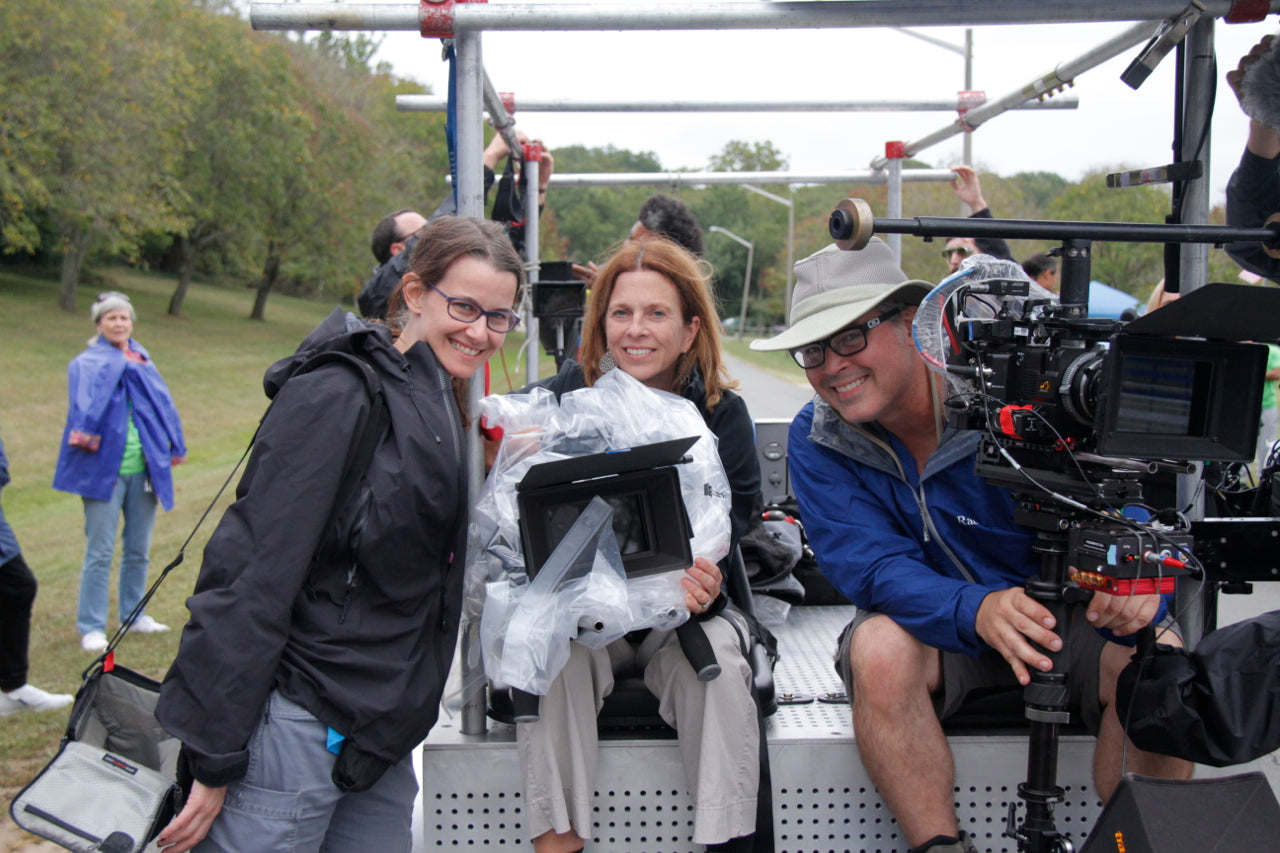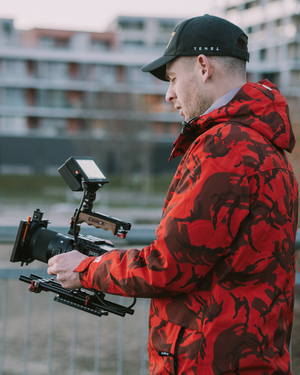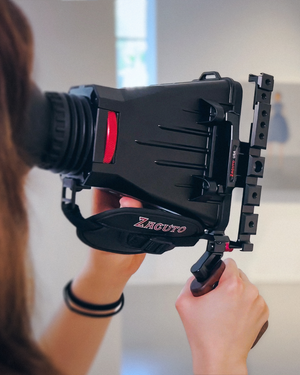
Behind the Scenes Look at TRI
with DP Jendra Jarnagin
Jendra Jarnagin is the Director of Photography on TRI - an inspirational independent feature film about people training for their first triathlon and the amazing community of diverse triathletes that support one another in overcoming personal obstacles. Natalie, an ultrasound tech with a history of not finishing things, is inspired by a cancer patient to sign up for a triathlon. Natalie is introduced to the strange (and aerodynamic) world of triathletes and meets a colorful cast of characters as she trains for the Nation’s Triathlon. With the support of her new teammates, she digs deep to discover just how far she can push her mind and body. Jendra and her team shot in September 2015 in the Washington DC area. The film was directed by Jai Jamison and produced by Ted Adams III, Kimberly Skyrme and Tara Gorman. The film was inspired by the producers’ involvement in the triathlon community. DP Jendra Jarnagin stops to smile with operators Sheila Smith and Jim Ball riding on the electric car for the finish line scenes CREDIT: Chris Beattie
DP Jendra Jarnagin stops to smile with operators Sheila Smith and Jim Ball riding on the electric car for the finish line scenes CREDIT: Chris BeattieHow would you describe the visual style of the film?
The first thing that the director, Jai, said to me was that it was important that the film not feel like a documentary. We wanted to adopt a story and character based approach to the narrative: to feel what these individuals were going through. It was interesting to me, being that my main strength is my lighting background, that most of the film was day exterior and I didn’t have lighting to use as my primary tool to evoke mood and tone. Working this way really had me dive deeper into the psychology and subtleties of the use of camera and made me realize how much I have been using lighting as my primary means of expression. I like to do a visual arc along with the character and/or story arcs, so in this case, we conveyed that using different kinds of camera movement. It’s subtle, but if you pay close attention to the shooting, you can tell that there is an evolution between sedentary and dynamic, as the main character gets more and more active, as well as a contrast between handheld and Steadicam and other smoother camera platforms, based on the comfort level of the characters and how they relate to what they are experiencing.Tell us about your gear and why you chose it.
The shoot started at the Luray Triathlon, a few weeks before principal photography, and we used Blackmagic Ursa 4K cameras for that, though we ended up switching to Sony F55s as our primary cameras for most of the movie. I also made frequent use of two Blackmagic Pocket cameras that I used for a bunch of bike rigs, as well as in an underwater housing. We occasionally used a GoPro for some specialty shots, like on the head of a swimmer during the race (which turned out to be one of my favorite shots) and for throwing a bike into a tree, but I specifically shied away from GoPros because of the fish-eye feel and the amateur connotation of immersive sports hobbyist videos that felt too documentary for the visual style of this film. I instead used Pocket cameras because of the interchangeable lenses and manual exposure, and especially the extended dynamic range of shooting RAW. I really fell in love with those powerful little things. I also used the Zacuto Marauder and Enforcer run'n'gun rigs along with the Pockets, for flexibility and stability. I wasn’t quite sure in advance how I would use them, but I just felt they would be useful to have on hand, and they saved the day a few times. We needed to do a handheld whip pan from a motorcycle to cut together a stunt sequence, and I felt the F55 Handheld would be too bulky to do that safely. So we used the Pocket with a Z-Finder and one of those rigs, which was perfect. A Camera Operator Jim Ball shoots off the back of a motorcycle with a Marauder rig and Blackmagic Pocket Cam. CREDIT Jendra Jarnagin
A Camera Operator Jim Ball shoots off the back of a motorcycle with a Marauder rig and Blackmagic Pocket Cam. CREDIT Jendra JarnaginTell us about one highpoint and one lowpoint of your project.
In this case, they were interrelated. This film presented me the biggest challenge I have ever faced on a project. I had to shoot my climax scene (19 pages of content) during a live event, Nation’s Triathlon in downtown Washington DC. It’s the biggest triathlon in the US with 4000 participants, and though we had major support from the event, we also had major limitations and mandate that we not interfere with any of the competitor’s experience. The bulk of the event spanned five hours, and we had 5 different characters experience of the race to capture. So the only way to accomplish this was to split into different units to shoot simultaneously. We utilized 14 cameras, 9 units, and a crew of 70: 24 of which were camera department. Not only was the prep and level of detail exhausting, but communicating everyone’s marching orders and disseminating all that information to that many people, many of whom were joining the team for the first time, was a huge ordeal. We had an entire work day the day before to prep the crew, walk through the event location, build and set up all the cameras, go over maps and visual references, etc. My goal was to empower all the unit DPs and camera operators to make their own unsupervised choices that were keeping with the vision of the film. The low point came the day before this huge prep day when we got word that many aspects of our parks department permit were being denied despite weeks of planning and daily communication with the event producers. So the ADs, producers, director, and I had to pull an all-nighter to totally re-work weeks of planning by morning in order to give presentations and prepare handouts for 70 people. It was an exhausting and complicated day, the hardest day of my professional life so far. Gaffer Reddog the Gaffer checks the sun in the clouds while operator Stefan Wiesen lines up a shot with Walker Hays at Nation's Tri with 2nd AC Nate Spivey and 1st AC Alex Guckert
Gaffer Reddog the Gaffer checks the sun in the clouds while operator Stefan Wiesen lines up a shot with Walker Hays at Nation's Tri with 2nd AC Nate Spivey and 1st AC Alex Guckert CREDIT Jendra Jarnagin


Leave a comment